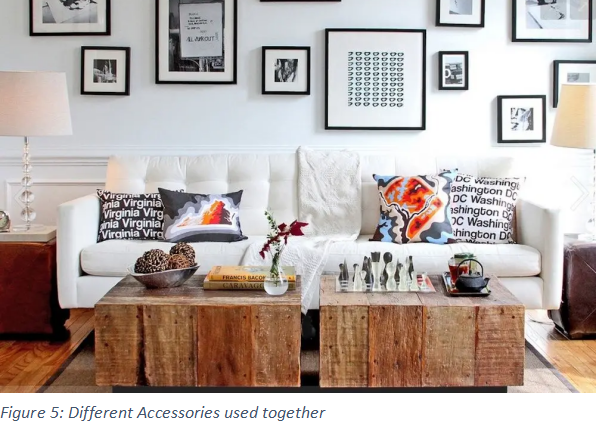Blog
Key Factors in Interior Designing
- April 28, 2023
- Posted by: Arafat Aziz
- Category: Interior Design Blog

According to my experience spanning over a decade as an architect designing several residential and commercial projects, I have concluded that designing the Interiors of a space can be very challenging as it always decides how it will be perceived and experienced by the end users which could range from inhabitants to visitors, from owners to employees, etc.
Interiors based on concepts can create a welcoming atmosphere with unique personalities and aesthetics which could be easily identified from a collection of different designs. Some key approaches that should be considered while designing interiors are discussed below.
 Space planning:
Space planning:
As a designer, it is important to create an efficient layout with a flow of space which are crucial in creating good interiors. The first step in designing any interior irrespective of the design type is Interior space planning which elaborates and explains the purpose of the space.
Any design is primarily determined to be functional and feasible on the basis of its spatial planning. It explains, what activities will be done in the provided space. The space should be arranged to promote easy movement and functionality. It’s by far the most important factor which is to consider the purpose of the space and the needs of the people who will be using it.
For example, a living room might be used for relaxing, entertaining, and watching television, while an office space might need to accommodate a desk, computer, and storage for files and paperwork. Without space planning, it is always almost impossible to achieve the ambiance you want to create or even fail the overall design. It is definitely the most important factor which is best to consider at the very beginning of designing the Interiors.


Color scheme:
Another important factor to consider while designing Interiors is color schemes. Through my experience, I have concluded that it is one of the most powerful methods that represent and influences the psychology of the client and end user.
The color scheme of a space can greatly impact the mood and atmosphere which can make the difference in creating a cohesive and inviting space. Warm colors like reds, oranges, and yellows create a cozy and inviting atmosphere, while cool colors like blues, greens, and purples can create a calming and serene environment. Neutrals like whites, greys, and beiges can provide a clean and modern look.
By mixing different colors, one can create the desired essence of design that is both functional and aesthetically pleasing. Whether you choose a monochromatic, complimentary, analogous or triadic color scheme, the key is to create a cohesive and inviting space that reflects the mood and purpose of the room.
Lighting:
Lighting is another crucial factor in creating a well-designed interior. Good lighting can enhance the functionality of a space, highlight certain features, and create a desired mood. The lighting can enhance the overall aesthetic of a room, as well as create a warm and inviting atmosphere. Natural light is ideal, but artificial lighting can be just as effective if used properly. Lighting can be elaborated as:
- Ambient lighting: This type of lighting is installed to illuminate the entire room which directly influences the perception of design. This can be achieved through overhead fixtures such as ceiling lights or chandeliers, as well as through natural light sources such as windows.
- Task lighting: A focused lighting installed to perform a specific task which could range from different activities performed in a provided design space. Examples of task lighting include desk lamps, under-cabinet lighting in the kitchen, and reading lamps next to a chair.
- Accent lighting is used to highlight specific features or objects in a room, such as artwork, sculptures, or architectural details. This can be achieved through recessed lighting, track lighting, or wall-mounted fixtures.
Another important aspect of lighting in interiors is the placement and direction of the fixtures. Overhead lighting should be evenly distributed throughout the room to avoid any areas of shadow or glare. Task lighting should be placed in a way that provides direct light without causing eye strain or discomfort
Task lighting, ambient lighting, and accent lighting are all important to consider. It’s also important to consider the style and design of the lighting fixtures. Light fixtures can serve as a decorative element in a room and should be chosen to complement the overall design aesthetic. For example, a modern minimalist room might benefit from sleek and simple lighting fixtures, while a traditional room might benefit from ornate and decorative fixtures.
lighting is a crucial aspect of interior design that should not be overlooked. By considering the type, colour temperature, placement, and design of lighting fixtures, designers can create a functional and aesthetically pleasing environment. Whether you are looking to create a warm and cozy atmosphere or a bright and energizing space, the right lighting can make all the difference.

Furniture:
A space’s furniture should be functional and aesthetically pleasing. It should be appropriately scaled for the room and arranged to promote good flow and functionality. The style of the furniture should also reflect the overall design aesthetic of the space.
The first step in choosing furniture for a space is to consider the purpose and function of the room. For example, a living room might require comfortable seating for relaxation and socializing, while a home office might require a desk and chair for work. It’s also important to consider the size and layout of the room.
Furniture should be chosen to fit the scale and proportions of the space, while also allowing for easy movement and flow. For example, a large sectional sofa might be overwhelming in a small living room, while a small loveseat might not provide enough seating in a larger space. It’s also important to consider the size and layout of the room. Furniture should be chosen to fit the scale and proportions of the space, while also allowing for easy movement and flow.
For example, a large sectional sofa might be overwhelming in a small living room, while a small loveseat might not provide enough seating in a larger space. In addition to size and function, it’s also important to consider the style and design of the furniture. Furniture can serve as a decorative element in a room and should be chosen to complement the overall design aesthetic.
For example, a modern minimalist room might benefit from sleek and simple furniture, while a traditional room might benefit from ornate and decorative pieces. furniture is an essential aspect of interior design that should not be overlooked. By considering the function, size, style, materials, and colour of the furniture, designers can create a functional and aesthetically pleasing environment. Whether you are looking to create any type of space, the right furniture can make all the difference.
 Accessories:
Accessories:
Another important feature that is usually neglected from the start while designing Interiors is the accessories. Certainly, I have experienced that many times whole design is influenced on the basis of a few accessories, and in other cases accessories are neglected and added later on a continuing base. Accessories are an integral part of interior design, adding depth, texture, and personality to a space.
They are the finishing touches that complete a room, and they can make a significant impact on the overall look and feel of a space. Accessories are the finishing touches that can tie a space together, which sometimes are not needed but most of the time provide the necessary knot to create the design in a holistic manner. They can add personality and character to a room and can be used to highlight specific design elements.
Accessories are often used to create or maintain the principles of design in Interiors. However, it’s important to not go overboard with accessories and clutter the space. When choosing accessories, it is important to consider the size, scale, and proportion of the items. Large items can overwhelm a small space, while small items may get lost in a large room.
It is also important to consider the overall style and theme of a room. For example, a modern room may benefit from sleek, minimalist accessories, while a traditional room may benefit from more ornate and decorative accessories.
Another critical role that accessories play in interior design is to provide a sense of balance and harmony. They can help tie together different elements of a room, creating a cohesive look and feel. When choosing accessories, it is essential to consider the existing colors, patterns, and textures in a space. This will ensure that the accessories complement the overall design scheme and do not clash with other elements in the room. Without accessories, a room can feel bare and uninviting. Adding accessories can be an easy and affordable way to refresh a space without the need for a complete redesign.
There are many other factors that influence the design but up to my knowledge and experience, good interiors of any space are a combination of many different elements that work together to create a welcoming, functional, and visually appealing space creating an ambiance desired by the owner. By considering the color scheme, lighting, furniture, accessories, and space planning, one can create a space that reflects a unique style and enhances the quality of life of the end users.
Leave a Reply Cancel reply
You must be logged in to post a comment.

 Space planning:
Space planning:  Accessories:
Accessories: